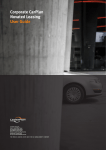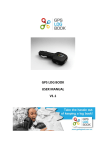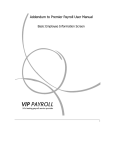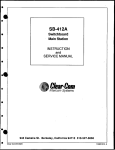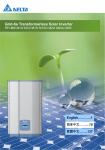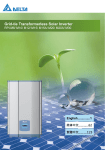Download Government CarPlan User Guide - Federation University Australia
Transcript
Government CarPlan User Guide LeasePlan Australia Level 7, South Wharf Tower 30 Convention Centre Place South Wharf, Victoria 3006 PO Box 6297 St Kilda Road Central Melbourne, Victoria 8008 Tel: 132 572 www.leaseplan.com.au Table of contents SECTION 1 INTRODUCTION TO GOVERNMENT CARPLAN 4 1.1 What is a Government CarPlan lease? 4 1.2 How does a Government CarPlan lease work? 4 1.3 Is a Government CarPlan your car or a company car? 4 1.4 What are the benefits of using a Government CarPlan vehicle? 4 1.5 What is the hand-back option/early return guarantee? 4 1.6 What happens if your employment terminates? 4 SECTION 2 OBTAINING YOUR SALARY VEHICLE PACKAGED 5 2.1 Deciding on your vehicle 5 2.2 Sourcing of vehicles 5 2.3 To obtain a quote on a vehicle 5 2.4 Information provided in the lease quote 5 2.5 Lease payment 6 2.6 Maintenance and repairs 6 2.7 Tyres, batteries and windscreen replacement 6 2.8 Registrations and CTP 6 2.9 Roadside Assistance 6 2.10 Fuel 6 2.11 Miscellaneous Operating Cost 6 2.12 Replacement vehicles (optional) 6 2.13 LeasePlan comprehensive insurance 7 2.14 Order process 7 2.15 Regular reporting 7 2.16 FBT tracking services 7 2.17 Variations to operating costs 7 2.18 Incorrect estimate of travel 7 2.19 How FBT affects your package costs 7 2.20 Effects of distance travelled and FBT 7 2.21 To claim ‘out of pocket expense’ reimbursement 8 2.22 Expiry of the contracted lease term 8 2.23 Failure to advise end of lease option 8 2 user guide SECTION 3 OBTAINING YOUR NOVATED VEHICLE 9 3.1 The Employee Contribution Method 9 3.2 Will ECM be beneficial to me? 9 3.3 GST on ECM 9 3.4 How do I nominate that I want to use ECM? 9 3.5 ECM - The impact of doing more or less kilometres per year 9 SECTION 4 SUPPLIMENTRAY INFORMATION 10 4.1 ATO Tax Scales 10 4.2 FBT Calculation 10 4.3 FBT Liability 11 4.4 Cash claim - Minimum amount claimable 11 3 user guide SECTION 1 INTRODUCTION TO SALARY PACKAGED LEASING 1.1 What is a Government CarPlan lease? The Government CarPlan lease is an arrangement between your employer and LeasePlan, enabling you to use the vehicle for the term of the lease. All costs associated with financing and operating the vehicle, including FBT liability, are deducted from your income. 1.2 How does a Government CarPlan lease work? Under the arrangement, you select a new vehicle from the LeasePlan predefined list of vehicles which draw deep Government discounts. Your employer leases the car from LeasePlan at the purchase pricing that is applicable to your employer and enters into a standard Operating Lease Agreement. You are assigned the right to use the vehicle for the term of the lease in return for your commitment to reimburse your employer for the costs of providing you with the vehicle. Your employer pays the lease rentals and operating costs directly to LeasePlan and recovers these (together with FBT liability) from your pre-tax, or a combination of pre-tax and post-tax salary. 1.3 Is a Government CarPlan your car or a company car? A Government CarPlan vehicle is still your employer’s car. To be eligible for a Government CarPlan vehicle you must qualify for the use and allocation of a Government vehicle and the vehicle must be available for business usage. In order for you to achieve the maximum benefit under this arrangement you should treat the car as your own because you have the potential to receive the benefit of lower running costs by looking after the vehicle. If you fail to look after the vehicle the additional costs will directly impact you. 1.4 What are the benefits of using a Government CarPlan vehicle? • You obtain a vehicle at reduced pricing (Government Tender Board Pricing and GST Input Tax Credits) Significant pre-tax savings on lease and operating costs Eliminate FBT liability with the Employee Contribution Method (ECM) Great savings above retail on vehicle costs Vehicles that have been carefully taken care of will normally have higher resale values as well as lower running costs. These savings are passed on to you. LeasePlan can claim a GST Input Tax Credit on the vehicle purchase and on all operating costs, so you will enjoy GST free motoring. You only pay GST on the residual value at lease expiry if you purchase the vehicle. • • • • • • Your vehicle can be returned at no cost or purchase outright if employment is terminated 1.5 What is the hand-back option / early return guarantee? You may terminate your lease in the event that you resign, retire, die, are dismissed, retrenched, are on maternity/paternity leave or extended leave without pay. You simply return the vehicle to a LeasePlan nominated site and walk away. Early return of the vehicle may incur cost of damage, and pro-rata kilometres travelled in excess of budget or any deficit that may occur in the ‘Miscellaneous Operating Costs’ and ‘Replacement Car’ expenditure account, which will be billed to you. These costs will be collected from you upon the return of the vehicle. 1.6 What happens if your employment terminates? If your employment is terminated, you can choose one of these three options: Option 1 – Early terminate the lease by purchasing the vehicle at the lease payout value (including GST) on your day of departure. Operating costs are reconciled within seven days of the lease termination. Any surplus/deficit in actual operating costs compared to budgeted costs will be refunded/invoiced to your employer and then provided/ recovered provided to you via your employer payroll. Options 2 – Assign the vehicle to another employee (subject to agreement between the new employee and your employer). Option 3 – Return the vehicle to LeasePlan. If there is damage to the vehicle, excess kilometres or a deficit balance in miscellaneous operating costs expenses, (Section 1.5) and replacement car, these amounts will be settled by you upon the return of the vehicle. Under Options 2 and 3 no operating cost reconciliation is undertaken. 4 user guide SECTION 2 OBTAINING YOUR SALARY VEHICLE PACKAGED 2.1 Deciding on your vehicle To help you assess whether a salary packaged lease is right for you and which vehicle best meets your needs, LeasePlan recommends you utilise LeasePlan Online at www.leaseplan.com.au. Your log on details will be provided to you by your employer (normally on your company intranet site or through Human Resources) or you can call LeasePlan on 132 572. If you are unable to utilise LeasePlan Online call us and we will provide you with the required documents to get you a quote. LeasePlan Online provides you easy online access to: • • • • • • • • Fast, accurate quotes in real time and 24/7 access Create multiple quotes to compare before deciding on your best option Browse and select additional options to a maximum value of 15% of the total purchase price (once the vehicle has been delivered, you cannot add further options to your lease) Request and order on the quote you decide to accept and apply for credit Update your personal profile online View current lease details at anytime News, tips and hints from LeasePlan An Online Help function When logging in for the first time you will be asked to complete ‘My Profile’. Information required to be completed in your profile includes: • • • • • 2.2 Your employment details Name and date of birth Drivers licence details Contact information for you Residential address and postal address details Sourcing of vehicles LeasePlan has a preferred dealer network and LeasePlan Online pricing reflects the discounts we are able to offer. To find out who these dealers are, visit the LeasePlan website (www.leaseplan.com.au) and use the New Vehicle Supplier Finder, located under 'Fleet Manager Toolkit' or call LeasePlan. If you decide to obtain your own pricing from an alternate source, this must be obtained before entering these details into LeasePlan Online. The quote from the dealer must include the following information: • Description of vehicle (including all options and accessories) • • • Dealer on road costs (including stamp duty, registration and CTP) Availability (expected delivery date) Trade-in value allowed (if applicable) If LeasePlan’s preferred dealer pricing is better than pricing you obtain from your own supplier LeasePlan may require the order is placed via its preferred dealer or decline quote. Remember, if talking to a dealer do not sign or commit to the purchase of a vehicle. 2.3 To obtain a quote on a vehicle The easiest way to get accurate quotes on a salary packaged lease is to use LeasePlan Online. LeasePlan’s website includes an online affordability and lease package calculator to help you see what type of vehicle best suits your budget. The comprehensive quote generator found in the secure area of LeasePlan Online then allows you to quote on a range of new vehicle choices, using different variables of vehicle model, lease term, residual value, annual distance travelled and your personal salary details. It is important to forecast as accurately as possible the estimated travel per annum. LeasePlan Online is designed to provide a final, accurate quote that you can then submit to order. If circumstances prevent you from quoting via LeasePlan Online, call or email LeasePlan. Please be aware, depending on the vehicle and lease parameters, this formal process can take up to 10 days from quote to order. New vehicle delivery lead times vary greatly with each manufacturer. LeasePlan generally recommends that you allow up to three months ensuring that special build and specific colour requirements can be met. LeasePlan will advise you of the expected delivery date, however this is subject to change and can be influenced by unforeseen manufacturer or shipping delays. You will be advised of any changes. 2.4 Information provided in the lease quote The quote will list the price of the vehicle and a full budget for the running of your vehicle for the term and kilometres indicated. It includes monthly and annual figures for: • • • • • • • • • Lease Payment Maintenance and Repairs Tyres Registration Roadside Assistance Fuel Miscellaneous Operating Cost Replacement Vehicle (optional) LeasePlan Comprehensive Insurance 5 user guide • • • • • • 2.5 Management Fees Budgeted FBT liability FBT ECM off-set (if ECM is used) GST on ECM post-tax contributions (if ECM is used) Employee package allocation for salary deduction Pre-tax and post-tax lease payment split (if ECM is used) Lease Payment The lease payment is the cost that LeasePlan as the financier charges to finance your vehicle for the nominated lease term. The various lease attributes relating to your vehicle (amount financed, interest rate, lease residual value, lease term) are used to calculate this lease payment amount. 2.6 Maintenance and Repairs All servicing and repair work to your vehicle must be pre-authorised by LeasePlan to ensure application of the best negotiated service and parts prices. Our team of maintenance controllers are qualified mechanics, committed to ensuring that all work carried out on your vehicle is necessary to ensure your safety and that the vehicle is maintained in a sound condition. When booking your vehicle in for work you must advise the service supplier that it is a LeasePlan-managed vehicle. The service supplier will use LeasePlan Online or call LeasePlan for pre-work authorisation and all invoices for work are billed to and paid by LeasePlan. Use a manufacturer-approved dealership for the servicing or repairing of your vehicle. The service supplier must be an approved repairer of LeasePlan. To find out who these dealers are please visit the LeasePlan website at www.leaseplan.com.au, select ‘Find a Maintenance Supplier’ or call LeasePlan. 2.8 Registrations and CTP Your vehicle will be registered by the dealer under your employer’s name, with LeasePlan noted as the fleet manager for renewal purposes. If Compulsory Third Party (CTP) insurance is required LeasePlan will automatically renew it as well. Where required by state regulations it is your responsibility to affix the label to your windscreen. 2.9 Roadside Assistance This service compliments any membership provided by your vehicle’s manufacturer. For example, if your vehicle manufacturer offers a two year warranty but your lease is for four years this service kicks in when the manufacturer warranty expires. The budget set for this service is only for the time the vehicle is not covered under a manufacturer warranty. 2.10 Fuel Fuel will be included in your vehicle budget. You will be provided with a single fuel card that can be used at any Caltex/Woolworths/Ampol/Safeway service station (unless your employer directs alternative fuel suppliers). It is essential for accurate reporting that correct odometer readings are provided at every fuel fill. Fuel discounts have been negotiated by LeasePlan and your employer, with the discount then passed on to you. 2.11 Miscellaneous Operating Cost Vehicle maintenance and repair budgets are based upon manufacturers’ specified servicing schedules, as well as any repairs that are the result of normal driving and fair wear and tear (brakes, exhaust, etc). There are several items excluded from standard maintenance programs, including broken glass, non-standard maintenance items, minor impact damage and vandalism. A budget called “Miscellaneous Operating Cost” has been built to accommodate these items. Insurance excesses can also be paid through this cost provision with the benefit of becoming pre-tax costs for you. 2.7 2.12 Replacement Vehicle (optional) Tyres, batteries and windscreen replacement Details of approved suppliers for tyres, batteries and windscreen replacement can be found in the wallet-sized LeasePlan Easy Guide provided with each vehicle at delivery, or via the online 'Find a Maintenance Supplier' tool at www.leaseplan.com.au. The replacement vehicle service is provided where vehicles are off the road for more than one day due to major maintenance/repair. Any costs for providing a replacement vehicle will be included as part of the reconciliation against budgeted costs. Please note: If you elect to remove the replacement vehicle budget from your salary sacrifice package, you will have to make alternative arrangements and pay for any replacement vehicle independent of LeasePlan. 6 user guide 2.13 LeasePlan comprehensive insurance 2.17 Variations to operating costs LeasePlan offers competitive premiums for total cover insurance. The premium is budgeted for in the lease payment and is paid as part of your packaging benefit. These premiums are subject to annual review and an individual’s claims history. Information on LeasePlan’s insurance policy, its terms and conditions is available at www.leaseplan.com.au Each quote will be provided with a budget for operating costs that are based on annual distance travelled and the type of vehicle. Often there will be unused budget at the end of the first year. This is because operating costs are generally lower in the initial part of a lease when vehicles have lower servicing requirements, creating a budget surplus for the first few months of the lease. Further into the lease the unused budget will diminish as tyre replacement and major service intervals occur. A final reconciliation will be performed at the completion of your lease. 2.14 Order process To authorise a quote to order the vehicle simply highlight the quote and click the ‘Save & Order’ button on LeasePlan Online, or return the signed quote to LeasePlan fax on 1800 331 041. Utilising LeasePlan Online ensures a shorter turn-around time for you. In both instances you will be required to complete a credit application and will be asked to provide additional supporting documentation. Omissions or providing insufficient information on your application could cause delays. If you decide to change details of the vehicle order (add options or accessories, delivery instructions, etc) you may do so through LeasePlan Online. Cancellation of an order may incur cancellation fees and cannot be complete via LeasePlan Online. Call LeasePlan to discuss. 2.15 Regular reporting You will receive a monthly Motor Vehicle Report (MVR) comparing actual and budgeted costs for the reporting period, as well as the cumulative actual versus budgeted costs. Accurate odometer readings at fuel fills will verify kilometres travelled against initial estimates. It will also highlight your target odometer reading at completion of the current FBT year and track your progress. A warning is provided if you are in danger of falling into a more costly FBT bracket, including an estimation of excess FBT liability. 2.16 FBT tracking services Vehicle kilometre information is contained in the monthly vehicle report to assist with monitoring your lease. Each monthly report shows the remaining average monthly kilometres required to be travelled to reach your target set for the FBT year. It will also indicate an anticipated FBT liability where your kilometres are below the budgeted FBT bracket. Please note: If you fail to provide accurate odometer reading at each fuel fill our ability to provide this FBT tracking service will be limited and could provide incorrect kilometre target calculations. If your vehicle costs less to operate than the budgeted amount then any surplus will be returned to you via your employer’s payroll at the end of your lease. This is because of the prevailing Income Taxation laws. Conversely, if final costs are greater than anticipated these costs will be billed to you via your employer’s payroll. If a major cost deficit or surplus occurs during your lease, LeasePlan can recalculate your lease to modify the variance. Your approval is sought, however is not required. 2.18 Incorrect estimate of travel LeasePlan regularly reviews budgeted versus actual costs and kilometres travelled. If abnormal (> 15%) debits or credits are being generated or significant kilometre variations arise, we will contact you to advise on a new budget and therefore a new package allocation. 2.19 How FBT affects your package costs When you obtain a vehicle under a salary packaged lease arrangement your employer becomes liable for Car Fringe Benefit Tax. The FBT liability, which your employer incurs, is charged back to you as part of your salary deduction. Refer Section 4.2 for examples of FBT calculations. 2.20 Effects of distance travelled and FBT Estimated Car FBT liability is based on your estimated annual kilometres at the time a quote is prepared. FBT liability in reality is paid on the actual kilometres travelled between 1 April and 31 March. If your annual usage falls into a different kilometre band as shown on the Statutory Factor table (refer Section 4.2), the Car FBT liability allocation to your vehicle will be either greater or less than the initial estimates in our quote. ‘Days Unavailable’ will not reduce the target odometer. Your monthly Motor Vehicle Report will highlight if existing usage trends are likely to cause a change to initial Car FBT estimates. 7 user guide 2.22 To claim ‘out of pocket expense’ reimbursement Cash Claim forms may only be used to claim reimbursement of costs incurred in emergency situations, for instance, where the allocated fuel cards could not be used, or for minor mechanical repairs of an urgent nature only (not for normal schedule servicing). Cash Claim forms are available at www.leaseplan.com.au For confirmation of the minimum amount claimable, please refer to Section 4.4. 2.23 Failure to advise end of lease option fee If you fail to advise your end of lease option within 28 days of the scheduled end date of the lease or fail to complete your obligation for your selected option, LeasePlan must undertake actions within its systems to allow the lease to continue or be extended for an additional lease term. If this occurs an administration fee will be applied to your lease for each additional term that is actioned by LeasePlan as a result of your failure to advise or complete obligations. The current administration fee that is applied is $300 per additional term. Please note you must attach the original tax invoice/receipts with the cash claim form. 2.23 Expiry of the contracted lease term Prior to the expiry of your contracted lease term you will be asked to exercise one of the following options before lease end: Option 1 - Purchase the vehicle at the residual value plus GST Option 2 - (If your employer allows) Extend your lease for a further term (minimum extension term of 12 months and conditions apply) Option 3 - Return the vehicle to a LeasePlan nominated site for sale Any surplus/deficit in actual operating costs compared to budgeted costs will be refunded/invoiced to your employer. Amounts refunded will be added to your payroll and will be subject to income tax. Where an amount has been invoiced this amount will be deducted from your payroll pre-tax. Under Option 3, net sales proceeds are compared to residual value and actual operating costs are compared to budgeted costs. Any surplus will be returned to your employer and passed back to you via your payroll and normal income taxes will apply. If there is damage to the vehicle, excess kilometres or a deficit balance in other provisions expenses and replacement car, these amounts are payable by you on the date of return. If you fail to nominate an option within the required timeframe or fail to fulfil your obligations under your selected options, the lease will be automatically extended for an additional three month term and a new rental may apply. 8 user guide SECTION 3 HOW TO IMPROVE YOUR PACKAGING BENEFIT WITH ECM (IF ECM IS ALLOWED BY YOUR EMPLOYER) 3.1 The Employee Contribution Method The Employee Contribution Method (ECM) is where you make a post-tax contribution towards the cost of operating your salary packaged lease. Instead of salary sacrificing the complete lease cost including Car FBT liability from pre-tax salary, a portion of the vehicle lease cost is deducted as an ‘employee contribution’ from your post-tax salary. This will show on your pay slip as a second salary deduction post-tax. Your post-tax contributions are then taken into consideration in your Car FBT calculations at the end of the FBT year. If you elect to use ECM, LeasePlan will calculate the post-tax contribution needed to completely eliminate your estimated Car FBT liability. By reducing or eliminating the Car FBT amount payable you lower the overall packaging cost and increase your disposable income. 3.2 Will ECM be beneficial to me? ECM makes salary packaging leasing more attractive for employees on incomes below the highest tax rate (Section 4.2). LeasePlan Online allows you to input your salary and will highlight the benefits to your disposable income (for varying taxable salary amounts) that are achieved by using ECM. A simple comparison is provided in Section 4.10. 3.3 GST on ECM When you make a post-tax contribution towards the cost of operating your vehicle using ECM, the transaction is classified as a ‘taxable supply’ by your employer, for GST purposes. This requires your employer to remit 1/11th of the post-tax contribution to the ATO. This additional GST must be added to your package cost. No input tax credits can be claimed for this transaction. 3.4 How do I nominate that I want to use ECM? If you want to use ECM to maximise the benefit for your salary packaged lease these steps need to be followed. The salary packaging analysis demonstrates the benefit gained by using ECM (pre and post-tax contributions) as compared to acquiring and operating the vehicle using 100% post-tax income. LeasePlan does not provide financial or taxation advice on salary packaging. We strongly encourage you to obtain independent taxation and financial advice to determine your personal salary packaging benefit. FOR AN EXISTING VEHICLE LEASE: If you have an existing LeasePlan salary packaged lease and you wish to add or remove ECM at any time, you need to submit a request in writing to [email protected] A mid-lease change will be implemented and a new Final Package Allocation will be issued to your employer for revised salary deductions. 3.5 ECM - The impact of doing more or less kilometres per year When preparing your lease quote, LeasePlan uses your estimated annual mileage to determine the estimated posttax deduction required to eliminate the FBT liability. If at the end of the FBT year you have travelled fewer kilometres than expected and you moved into a higher FBT bracket, you may incur an additional FBT liability. This is because your post-tax deductions were insufficient to offset the higher FBT liability. If you have travelled more kilometres than expected and have moved into a lower FBT bracket you will not incur a further FBT liability, however you may have had too much deducted from your salary post-tax, thus losing some of the advantage of higher pre-tax benefits. It is important that you regularly monitor your actual distance travelled via your monthly Motor Vehicle Report to ensure your usage does not cause you to move into another FBT bracket. If you provide accurate odometer readings with each fuel fill your Motor Vehicle Report will highlight your progress against your annual target. If your actual annual kilometres will be higher or lower than the target, contact LeasePlan on 1300 668 572 to arrange a mid lease change. FOR A NEW VEHICLE LEASE: When using LeasePlan Online to generate your lease quote, it will automatically apply ECM, calculating the post-tax element required to eliminate the estimated FBT liability. With ECM, the ‘total vehicle cost’ remains unchanged, however the quote will display the FBT liability that is offset by the post-tax contribution as well as the GST cost payable on the post-tax amount. The packaging cost is then displayed together with how this should be deducted, pre and post-tax from your salary. 9 user guide SECTION 4 SUPPLEMENTARY INFORMATION 4.1 ATO Tax Scales The following income tax rates apply from 1 July 2012. TAXABLE INCOME TAX ON THIS INCOME $1 – $18,200 Nil $18,201 – $37,000 19c for each $1 over $18,200 $37,001 – $80,000 $3,572 plus 32.5c for each $1 over $37,000 $80,001 – $180,000 $17,547 plus 37c for each $1 over $80,000 $180,001 and over $54,547 plus 45c for each $1 over $180,000 Some samples as to how the FBT statutory rates are applied are shown below Example 1 Lease commenced before 10 May 2011 – Old FBT rates apply for the term of the lease providing no change to lease expiry date or employer. * Does not include Medicare Levy. 4.2 If your vehicle lease commenced during an FBT year (1 April to 31 March) it is necessary to estimate the kilometres that would have been travelled if the car had been operated for the entire year. This is done by averaging the kilometres travelled per day from the initial delivery date and multiplying it by 365. For instance, where a lease commenced halfway through the FBT year and travelled 12,000 km, the annual distance would be 24,000 km and the 20% statutory rate (see tables above) would apply to the Car FBT liability calculation. FBT Calculation The Fringe Benefits Tax (FBT) legislation for motor vehicles was changed in the Federal Budget May 2011, impacting all vehicles acquired from 11/5/2011. If you enter into a lease contract after the 11/05/2011, the vehicle will be subject to the new method of FBT calculation to be phased in over the next four years. The final result will be that all salary packaged vehicles will be valued at 20% regardless of how many kilometres the car travels. Jane commenced her lease arrangement on 1/3/11 for 3 years, due to expire 28/2/14. From From From From 1/3/11 to 31/3/11 Jane’s car travels 2,200 kms 1/4/11 to 31/3/12 Jane’s car travels 27,000 kms 1/4/12 to 31/3/13 Jane’s car travels 10,000 kms 1/4/13 to 28/2/14 Jane’s car travels 19,000 kms For the FBT year from 1/3/11 to 31/3/11, the car has travelled 2,200 kms over 31 days. Therefore, annualised kilometres driven would be 2,200 x 365 / 31 = 25,903 kms. So the FBT The statutory rates below will apply on an increasing scale as statutory rate that will apply for the 2010/2011 FBT year will be 11%. set out in the table until the flat rate of 20% is achieved. STATUTORY RATE NEW VEHICLE LEASE CONTRACTS ENTERED INTO FROM 11 MAY 2011 INCLUSIVE DISTANCE TRAVELLED DURING THE FBT YEAR (1 Apr - 31 Mar) From 10 May 2011 From 1 April 2012 From 1 April 2013 From 1 April 0 - 14,999 20% 20% 20% 20% 15,000 - 24,999 20% 20% 20% 20% 25,000 - 40,000 14% 17% 20% 20% Greater than 40,000 10% 13% 17% 20%2014 For the FBT year ending 31/3/12, kms were 27,000 so a statutory rate of 11% is applied. For the FBT year ending 31/3/13, kms were 10,000 so a statutory rate of 26% is applied. For the FBT year from 1/4/13 to 28/2/14, the car has travelled 19,000 kms over 334 days. Therefore, annualised kilometres driven would be 19,000 x 365 / 334 = 20,763 kms. So the FBT statutory rate that will apply for 2013/2014 FBT year will be 20%. If you entered into your lease contract prior to the 11/05/2011 the old FBT rates listed below will apply for the life of the lease or until the lease is re-financed, extended for an additional lease term or change of employment occurs. KILOMETRES TRAVELLED PER ANNUM 0 - 14,999 26% 15,000 - 24,999 20% 25,000 - 40,000 11% Greater than 40,000 7% 10 user guide Example 2 How the FBT liability is calculated Lease Commences before 10 May 2011 – Subject to old FBT Statutory Rates, but lease is extended for an additional term when lease is due to expire. EXAMPLE: On 1 October 2012 a driver enters into a lease on a vehicle that has an FBT base value of $30,000. The vehicle travels 15,143 kms by 31/03/13 (the end of the FBT year). During this time the car was not available for private use for 10 days. Blake commenced his lease arrangement on 15/9/09, due to expire 14/9/11. From 1/4/11 to 31/3/12 Blake's car travels 32,000 kms From 1/4/12 to 14/9/12 Blake’s car travels 14,000 kms In August 2011, Blake refinanced the car for another year and documents were put in place to extend the lease by 12 months, so the new lease end date has changed to 14/9/12. This lease extension is considered by the ATO to be a new lease arrangement and Blake will now fall under the new arrangements for valuing car fringe benefits (from the beginning of the next FBT year following the date he signed/extended his lease - 1/4/12). STATUTORY RATE 15,143 x 365 days = 30,369km per annum = 17% Statutory Rate for the 182 days during the FBT period. CAR FBT LIABILITY FBT Base value $30,000 x Statutory Rate 17% x FBT Gross-up Factor 2.0647 / 365 x (182 days – 10 Days Unavailable) X FBT tax Rate 0.465 = $2,307.36 Please note: The Car FBT gross-up rate is calculated at the pre-GST FBT rate of 1.8692 if your employer is unable to claim an Input Tax Credit. For the FBT year ending 31/3/12, kms were 32,000 so a statutory rate of 11% is applied. For the FBT year from 1/4/12 to 14/9/12, the vehicle has travelled 14,000 kms over 167 days. Therefore, annualised kilometres driven would be 14,000 kms × 365 / 167 = 30,598 kms. So the FBT statutory rate that will apply for 2012/2013 FBT year will be 17%. Example 3 Lease Commences after 10 May 2011 – Subject to New FBT Transitional arrangements. James commenced his lease arrangement on 1/7/12 for 3 years, due to expire 30/6/15. From From From From 1/7/12 1/4/13 1/4/14 1/4/15 to to to to 31/3/13 James' car travels 35,000 kms 31/3/14 James' car travels 42,000 kms 31/3/15 James' car travels 41,000 kms 30/6/15 James' car travels 10,500 kms. For the FBT year from 1/7/12 to 31/3/13, the car has travelled 35,000 kms over 274 days. Therefore, annualised kilometres driven would be 35,000 × 365 / 274 = 46,624 kms. So the statutory rate that will apply for 2012/2013 FBT year will be 13%. For the FBT year ending 31/3/14, kms were 42,000 so a statutory rate of 17% is applied. For the FBT year ending 31/3/15, kms were 41,000 so a statutory rate of 20% is applied. For the FBT year from 1/04/15 to 30/6/15, the car has travelled 10,500 kms over 91 days. Therefore, annualised kilometres would be 10,500 × 365 / 91 = 42,115 kms. So the FBT statutory rate that will apply for the 2015/2016 FBT year will be 20%. 11 user guide 4.3 FBT Liability In order for your employer to report your Car FBT liability, you must submit an annual FBT declaration via www.leaseplan.com.au at the end of the FBT year (31 March). You are required to record your final odometer reading as at 31 March together with any exempt days (days where the vehicle was not available for use). Your employer will then reconcile your FBT balance with you via your payroll. FBT liability can be reduced or eliminated if you elect to use the Employee Contribution Method (ECM) when salary packaging your vehicle. For more details please refer to Section 3 of this guide. Statutory Method is normally used with salary packaged leases, however, in some special circumstances where there is a high degree of business use the Operating Cost Method may prove more effective. To use this method for FBT calculation you will need to keep a logbook for a continuous period of 12 weeks (minimum) to determine an accurate Business Use percentage. To obtain a lease quote using the Operating Cost Method you will need to submit your request by calling LeasePlan on 132 572 or email [email protected]. With your request you will need to supply: 1. The Private Use percentage (i.e. 100 – the Business Use percentage) 2. The Logbook Date – being the date of your last entry in your logbook. If you do not have a logbook you can supply an estimate and then provide your actual logbook details at a later time (i.e. within three months of the delivery of your vehicles or before then end of the FBT year). please note: ECM can also be applied using the Operating Cost Method. 4.4 Cash Claim – Minimum Amount Claimable There is a minimum amount of $55 claimable. Costs below this figure are borne by you. 12 user guide













